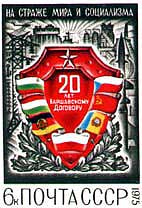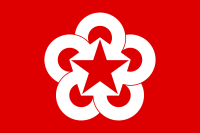Warsaw Pact
|
|||||||||||||||||||||||||||||||||||||||||||
The Warsaw Pact (see Nomenclature) was an organization of communist states in Central and Eastern Europe. It was established on May 14, 1955 in Warsaw, Poland. The treaty was signed in Warsaw on May 14, 1955 and official copies were made in Russian, Polish, Czech and German. The treaty was an initiative of the Soviet Union and was in direct response to West Germany joining the North Atlantic Treaty Organization (more commonly known by its English acronym NATO) in 1955. As such, the Warsaw Pact was the Soviet-sponsored military-treaty organization and the European Communist Bloc's counterpart to NATO; it was similar to NATO in that there was a political Consultative Committee, followed by a civilian secretary-general, while down the chain of command there was a military commander in chief and a combined staff, although the similarities between the two international organizations ended there. [1]
Contents |
Nomenclature
The treaty is officially known as the Treaty of Friendship, Cooperation and Mutual Assistance. "Warsaw Pact" is the more common term in Western countries, where it is sometimes abbreviated WAPA or sometimes simply WP. In other languages, the official title is:
- Bulgarian: Договор за дружба, сътрудничество и взаимопомощ
- Czech: Smlouva o přátelství, spolupráci a vzájemné pomoci
- German: Vertrag über Freundschaft, Zusammenarbeit und gegenseitigen Beistand
- Polish: Układ o Przyjaźni, Współpracy i Pomocy Wzajemnej
- Romanian: Tratatul de prietenie, cooperare şi asistenţă mutuală
- Russian: Договор о дружбе, сотрудничестве и взаимной помощи
- Romanization of Russian: Dogovor o druzhbe, sotrudnichestve i vzaimnoy pomoshchi
Members
Founding members:
 People's Republic of Albania (withdrew its support in 1961 as a result of the Sino-Soviet split, formally left in 1968)
People's Republic of Albania (withdrew its support in 1961 as a result of the Sino-Soviet split, formally left in 1968) People's Republic of Bulgaria (In Bulgarian: Народна Република България. Pronounciation: Narodna Republika Bulgaria)
People's Republic of Bulgaria (In Bulgarian: Народна Република България. Pronounciation: Narodna Republika Bulgaria) Czechoslovak Socialist Republic
Czechoslovak Socialist Republic People's Republic of Hungary
People's Republic of Hungary People's Republic of Poland
People's Republic of Poland Socialist Republic of Romania
Socialist Republic of Romania Union of Soviet Socialist Republics
Union of Soviet Socialist Republics
Joined later:
 German Democratic Republic (in 1956)
German Democratic Republic (in 1956)

Members of the Warsaw Pact pledged to defend each other if one or more of the members were attacked. The treaty also stated that relations among the signatories were based on mutual non-interference in internal affairs and respect for national sovereignty and independence.
In 1991, the Warsaw Pact broke up when most of the Communist governments fell, changing to a democratically elected form as the Soviet Union disintegrated.
Structure
The Warsaw Pact was divided into two branches: the Political Consultative Committee, which coordinated all non-military activities, and the Unified Command of Pact Armed Forces, which had authority over the troops assigned to it by member states and was headed by the Supreme Commander, who at the same time was the First Deputy Minister of Defence of the USSR. The head of the Warsaw Pact Unified Staff was the First Deputy Head of General Staff of the Ministry of Defence of the USSR.[2] The Warsaw Pact's headquarters were in Warsaw. Despite the fact there were two branches in charge of the armed forces they still reported to the party.
History

The pact was a Soviet initiative aimed at countering NATO. East Germany, Hungary, Albania, Czechoslovakia, Bulgaria, Romania, Poland, and the Soviet Union were the founding members.

There are many examples of soldiers of the Warsaw Pact serving alongside NATO soldiers on operational deployments under the auspices of the United Nations, for example Canadian and Polish soldiers both served on the UNEFME (United Nations Emergency Force, Middle East - also known as UNEF II) mission, and Polish and Canadian troops also served together in Vietnam on the International Commission of Control and Supervision (ICCS).
The Warsaw Pact was officially dissolved at a meeting in Prague on 1 July 1991. Vaclav Havel (the former President of Czechoslovakia) counts the dissolution of the Warsaw Pact as his greatest accomplishment, according to his 2007 memoir To The Castle and Back.
Post-Warsaw Pact
On 12 March 1999, the former Warsaw Pact members and successor states Hungary, Poland and the Czech Republic joined NATO. Bulgaria, Estonia, Latvia, Lithuania, Romania, and Slovakia followed suit in March 2004.
In November 2005 Poland decided to make its military archives regarding the Warsaw Pact publicly available through the Institute of National Remembrance. About 1,300 documents were declassified in January 2006 with the remaining approximately 100 documents being evaluated for future declassification by a historical commission. Finally, 30 were released, with 70 remaining classified as they involved issues with the current strategic situation of the Polish military. It was revealed in declassified documents that, until the 1980s, the Warsaw Pact's military plans in the case of war with the West (eg Seven Days to the River Rhine), consisted of a swift land offensive whose objective would have been to secure Western Europe quickly (using nuclear weapons if necessary). Poland itself was home to 178 nuclear missiles, growing to 250 in the late eighties. Warsaw Pact commanders made very few plans for the possibility of fighting a defensive war on their own territory.
See also
- Collective Security Treaty Organization (treaty between 6 post Soviet states)
References
- Modern History Sourcebook: The Warsaw Pact, 1955 (full text of the treaty)
- Parallel History Project on NATO and the Warsaw Pact
- This article contains material from the Library of Congress Country Studies, which are United States government publications in the public domain.
- Library of Congress / Federal Research Division / Country Studies / Area Handbook Series / Soviet Union / Appendix C: The Warsaw Pact (1989)
Further reading
- Vojtech Mastny, Malcolm Byrne, Magdalena Klotzbach: A Cardboard Castle? An Inside History of the Warsaw Pact, 1955-1991, Central European University Press, Budapest, 2005, ISBN-10 9637326081, ISBN-13 978-9637326080
- William J. Lewis: The Warsaw Pact: Arms, Doctrine and Strategy. Institute for Foreign Policy Analysis. 1982. ISBN 0-07-031746-1. This book presents an overview of all the Warsaw Pact armed forces as well as a section on Soviet strategy, a model land campaign which the Soviet Union could have conducted against NATO, a section on vehicles, weapons and aircraft, and a full-color section on the uniforms, nations badges and rank-insignia of all the nations of the Warsaw Pact.
- Václav Havel: To the Castle and Back New York: Alfred A Knopf, 2007.
- (German) Frank Umbach: Das rote Bündnis: Entwicklung und Zerfall des Warschauer Pakts, 1955-1991. Berlin: Christoph Links Verlag, 2005. 701 pp.
External links
- Documents of the Warsaw Pact archives, Parallel History Project on NATO and the Warsaw Pact (PHP)
|
||||||||||||||||||||||||||||||||||||||||||||
|
|||||||||


